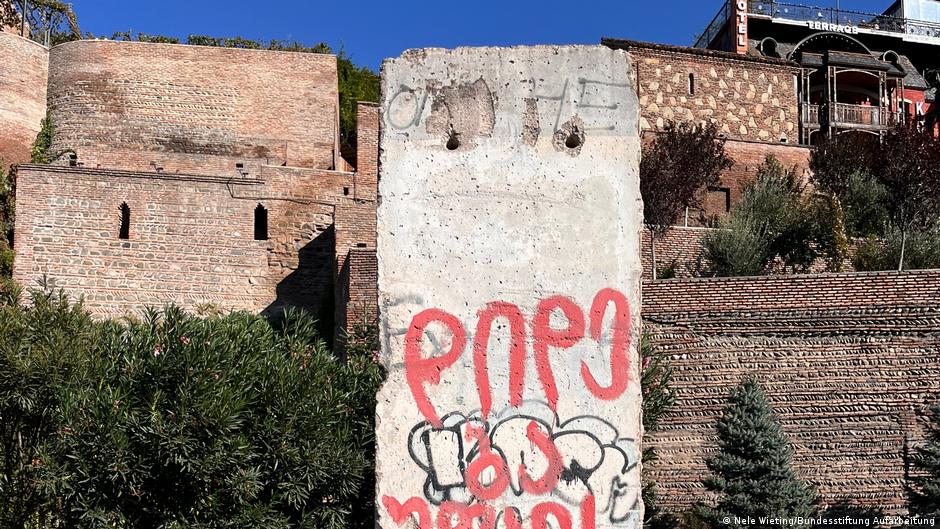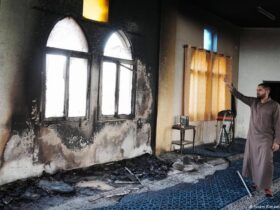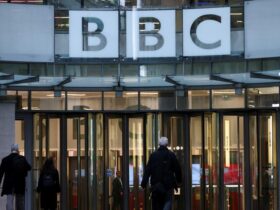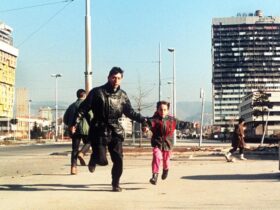An infamous symbol of the division of Germany, the Berlin Wall divided West Berlin – a separate enclave of the Federal Republic of Germany (FRG) – from East Berlin, in the German Democratic Republic (GDR) for 28 years.
Construction began in 1961 under orders of the GDR’s communist leadership, following the exodus of approximately three million people to the West. They were escaping a struggling economy, limited freedom, and government surveillance. To prevent further defections to the West, the East German government constructed a complex system of roadblocks, barriers, and guard towers along the 155 kilometer long border.
It was considered impenetrable – although over the years about 5,000 East Germans managed to cross it.
The Wall cut off almost all traffic routes and communication channels between East and West Berlin. Border-crossing points such as Checkpoint Charlie remained an exception.
At the Wall, the brutality of the GDR was put on full display. At least 140 people died there between 1961 and 1989. Apart from about 100 persons trying to escape, border guards and unsuspecting passers-by also lost their lives.
How did the Berlin Wall become an iconic monument?
When the communist bloc collapsed in Eastern Europe, the Berlin Wall also fell on November 9, 1989. German reunification took place about a year later.
Today, only a few sections of the Wall remain in Berlin.
The longest is the famous East Side Gallery, whose painted-concrete structure extends for 1.3 kilometers (0.8 mi). Another section can be found at the Berlin Wall Memorial.
When the Berlin Wall fell, the people of Berlin were eager to dismantle the oppressive structure as quickly as possible. At the same time, individuals, governments, and institutions around the world were eager to acquire pieces of it. The US, in particular, was very interested in acquiring sections of the wall.
According to estimates by the Federal Foundation for the Study of the Communist Dictatorship in East Germany, the US has more pieces of the Wall than Berlin. Whether in front of CIA headquarters in Langley or in a men’s restroom in Las Vegas, the Berlin Wall can be found all over the country.
“As one of the winners, the United States certainly played a major role when it came to divided Germany,” said Anna Kaminsky, director of the foundation.
“The Wall was a topic that was mentioned by almost all American presidents in foreign policy. It was fundamentally an emotional issue for America – especially for the American troops who were stationed in Berlin.”
Parts of the wall are spread not only in the US but around the world – from New Zealand to Iceland and from Indonesia to Chile. The German Foundation has identified 57 countries (besides Germany) where there is at least one piece. Each has its own story, and each is interpreted differently. Sometimes it was private people or companies who acquired the sections, while other times the German government or the Berlin Senate gifted them.
As a monument and a plea for unification
In South Korea, where a connection to German history can be felt due to the country’s isolation from the north, there are fragments of the wall at six different locations, including Dorasan, the northernmost point of the South Korean railway network along the North Korean border. In 2015, at the train station there, then-serving German President Joachim Gauck joined representatives of the South Korean government in opening the “Unification Forum” and unveiled a wall section with a plaque calling for “a reunified Korea and help the world become more peaceful.” Also engraved is a quote from Gauck: “Together to discover and build a life of freedom.”
Wall murals hold particular significance in some countries of the former Eastern Bloc, where they symbolize hard-won democracy.
This is the case in Bulgaria, where the municipal government of Sofia asked the Berlin Senate for a piece of the wall in 2006. It now stands next to the Memorial to the Victims of Communism in Bulgaria and is accompanied by two plaques that read in Bulgarian and German, “On August 13, 1961, a wall divided Berlin and Germany, and thus Europe and the world. Bulgaria remained trapped on the eastern side of the wall – until November 9, 1989, when the people tore it down. This section of the Berlin Wall is from the Berlin side. A gift to the citizens of Sofia – as a sign of a reunified Europe and proof that Bulgarians are now free.”
The section of the wall in Sofia is dull and gray – just like the original wall. However, many other parts have been painted over or tagged with graffiti – often accompanied by symbols of peace and friendship that reveal good intentions. Today, they seem more like a piece of pop culture than components of the once-dreaded border wall.
French artist and Berliner by choice Thierry Noir had painted the West Berlin side wall with the large-scale figures typical of his work even before November 9, 1989. But later he left his mark on the segments permanently.
“Germany’s Next Top Model” star Heidi Klum has a piece of the wall painted in her patio in California. It was a gift from her husband, who was born in East Germany.
Controversy: Parts of the wall sold for profit
After the fall of the Wall, the transitional government of the GDR at the time tasked a publicly owned company with selling the remains of the structure for a profit. In turn, that company cooperated with the West Berlin Agency. Together, they decided to paint the sections to increase their attractiveness and boost selling prices. Anna Kaminski explains, “This caused quite a protest – to see that the GDR government, together with representatives of the party that had built the wall where so many people died, were now seeking to make a profit by selling it.” However, the sale was intended to at least benefit the non-profit institutions. But private companies also make profits from the wall.
A work criticizing this practice can be found in the Norwegian city of Trondheim. There, artist Lars O. Ramberg created a sculpture titled “Capitalist Realism” for the municipal government. On the wall section, he wrote the word, “Sale.” The Berlin Wall symbolizes the attainment of freedom and also serves as an example of how this symbolic value can be purchased, the artist explained, adding that he was making himself part of the problem by acquiring sections of the Wall and creating the sculpture.
Over the past 10 years, requests for wall pieces have declined significantly. “World history has moved on and global politics are different,” says Anna Kaminsky. “The iconic impact of the Wall has diminished over the decades. It is rapidly losing its place as a symbol.”
Some say there are positive aspects to this too – because no matter how colorful it is or where it stands, the wall remains. Symbol of dictatorship.
This article was originally written in German.






Leave a Reply